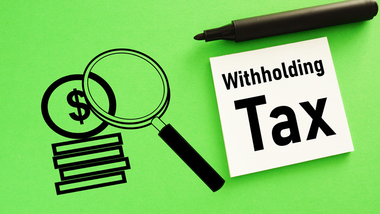
Is Your Withholding Correct?
 All year long, employers withhold income tax from the paychecks of their employees. Each paycheck is distributed to you after your employer has taken out a portion of your paycheck to pay the IRS on your behalf.
All year long, employers withhold income tax from the paychecks of their employees. Each paycheck is distributed to you after your employer has taken out a portion of your paycheck to pay the IRS on your behalf.
At the end of every year, your employer will send you a document called Form W-2, Wage and Tax Statement. Within this document, you will see the amount of money you were paid in wages as well as the amount of money that was withheld on your behalf.
The amount of money withheld in your name will depend not only on the annual income that you earn but also on the information you provided your employer via Form W-4, Employee’s Withholding Certificate. If you have any questions about how to fill out this form, refer to IRS Publication 505 for details.
Not only will you specify your filing status on Form W-4 but also you should complete the other parts of the form if you anticipate receiving additional income or deductions beyond the standard deduction. This is where you should indicate your eligibility for tax credits as well.
If your refund is either larger or smaller than you expected, look directly at the amount of money that is being withheld. Increase the amount to lessen the amount of any money that you owe when filing a return come tax season.
Here are times when you should check your withholding amount:
- After a major life event.
- When your income changes.
- At the start of every year.
- When tax laws change in ways that affect you.
- When you experience a lifestyle or financial change.
- If you get married or divorced.
- After having a child, purchasing a home, retiring or filing Chapter 11 bankruptcy.
- When your spouse either starts or stops working.
- If you have taxable income that is not subject to withholding.
- When there are changes to your planned deductions or eligible tax credits.
If you need to check the withholding amount, make use of the Tax Withholding Estimator tool on the official IRS website. This tool can help you figure out whether you need to submit a new Form W-4 to your employer.
If you have a pension or an annuity and you are not employed, turn to Form W-4P, Withholding Certificate for Periodic Pension or Annuity Payments, instead. This document is where you’ll estimate your tax withholding for these types of payments. And if you have a more complex tax situation, there’s understandably even more to consider.
Whether you owe an alternative minimum tax or you are responsible for paying tax on unearned income from dependents, you might even be in a situation where you have received nonwage income as dividends, capital gains, rents or royalties. If any of these circumstances apply to you, it’s important to review Publication 505, Tax Withholding and Estimated Tax.
This documentation includes worksheets and examples that can guide you according to your situation. However, if you have a nonresidential alien status, refer to the instructions in Notice 1392, Supplemental Form W-4, Instructions for Nonresident Aliens, instead.
With the assistance of Form W-4V, Voluntary Withholding Request, for any government payment, you can request that any amount of federal income tax is withheld regarding any of these matters:
- Unemployment compensation.
- Social Security benefits.
- Commodity Credit Corporation loans.
- Crop disaster payments.
- Alaska Native Corporations dividends and distributions.
Are you of the belief that you need to change your current withholding status? As mentioned, calculate your results with the Tax Withholding Estimator and use that information to complete a new Form W-4 to give to your employer. Make sure you submit it as soon as you finish filling out the form. Just don’t send the form to the IRS because it needs to be sent to your employer instead.
If you’re worried that you have been underpaying your taxes, you can adjust the amount of money being withheld from your paychecks as well. You can alter the amount of estimated tax payments that you make, too.
Either way, it’s important to make sure your withholding is right. If you need additional help with this tax-related matter, reach out to a professional or speak with your employer for further insight into your work-based taxes.



